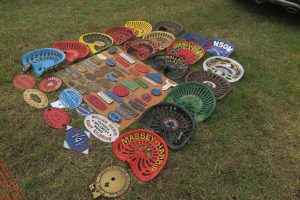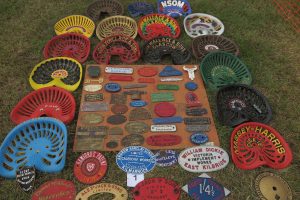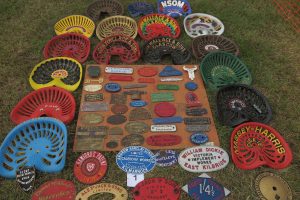The Royal Show, or the annual show of the Royal Agricultural Society of England, was a key event in the agricultural calendar, especially for English agriculturists. Scottish ones did attend, though their attendance varied according to the location of the show. The same was true for the Scottish implement and machine makers, though some did specially attend when they had new manufactures to show to the public, or when there were key trials for which they wanted to enter.
The number of Scottish exhibitors was generally small. They usually included some of the key ones. They brought with them their major manufactures to introduce them to an English and wider audience. These included ones that they were renowned for as well as improved ones. They also included ones that they considered filled a niche within the market for implements and machines.
The Scotsman included a lengthy account of the Scottish exhibitors to the Royal Show in July 1922. It is worth quoting at length as it says a lot about what was innovative and important about Scottish agricultural implement and machines and who were some of the most important makers. It states:
“… Imposing display of implements
There is a comprehensive display of implements and machinery, and the 494 separate stands occupy over 12,000 feet of shedding of various descriptions, in addition to some acres of open ground space. The tendency to combine implements and machines is well illustrated this year. The self-binder, for example, does the work of the reaping machine together. With what was formerly done by hand. Self-lift implements used with tractors from a combination appliance. Some of the latest machinery on view carries this process a step further. There are to be seen drills which also cultivate, how, sow corn, distribute fertiliser or lime, and roll. Again there are harrows combined with a skim plough or with a cultivator, mills which do both grinding and crushing, a manure distributor and sprayer and crusher all in one, and a combined stubble breaker and cultivator. It is through the development of power that such combinations of machines have become possible.
Scottish implements
Considering the distance of the Show from Scotland, there is a fine display of implements from north of the Tweed. About twenty makers are represented, and it says much for their enterprise that they should have come so far South to compete with the late English manufacturers on their own ground, and the varied and useful implements which they have on view make an exceedingly creditable appearance. Two Scottish manufacturers have entered for the Society’s silver medal for “new implements”. Many of these implements can hardly be called “new”, the main principles on which they operate having been in use for several years, but if they are not a distinct novelty, they all contain some advantageous features that bring them still nearer perfection, and secure greater efficiency in working. These improvements will, no doubt, receive critical attention at the hands of the practical farmers who examine them.
Mr George Henderson, 58 Leith Street, Edinburgh, is one of the exhibitors of new implements. He shows the “Waverley” manure distributor, which has a number of special features. It is designed to distribute every class of both wet and dry fertilisers, is unusually simple in construction, and has a hopper which is adjustable for hilly land. The force feed distribution is effected by a series of star wheels revolving in brass bushes, while the driving mechanism consists of a worm and pinion to each star wheel, which gives a direct and positive drive. The ball-bearing thrusts blocks are fitted to the ends of the driving shafts. The driving worm and pinions are entirely enclosed, and run in grease, and no fertilisers can reach the driving mechanism. The “Waverley” distributor can be fitted with a special attachment for sowing manure in drills or rows, and there is also a special transport which can be supplied to enable the machine to travel along narrow roads and through small gateways.
The other Scottish new implement is a 6 to 8 hp single sleeve valve engine known as the “Glasgow” Model M, on the stand of Messrs Wallace (Ltd), 34 Paton Street, Glasgow. The application of the single sleeve valve to stationary engines is new, although it has been used successfully on cars, marine engines, and motor cycles for some time. The advantages are that no poppet valves, tappets, springs &c are employed. The normal speed of the “Glasgow” is 800 revolutions per minute. There is a standard pulley supplied, which can be fitted on either side of the engine, and an extended boss to take any type of pulley. The engine starts on petrol from an auxiliary tank, and afterwards runs on paraffin. The cylinder has a head which is detachable by loosening four studs, and this is done without disturbing the valve gear.
There are no fewer than half a dozen exhibitors from Aberdeenshire.
Messrs Robert G. Garvie & Sons, Aberdeen, show a light portable threshing and oil engine mounted on a rigid frame, and fitted for use by one or two horses.
Messrs Barclay, Ross & Hutchison, Aberdeen, exhibit the Austin tractor, as well as threshing machine, manure distributor, and cultivator.
The Bon Accord Engineering Company have on view a four-foot wide portable threshing machine and a smaller type, oil engines, pumps for water or liquid manure, and drain cleaning rods.
Messrs Marshall & Philp, Aberdeen, show a series of spraying machines.
Mr James Marshall, Aberdeen, has a great array of egg boxes in all sizes to carry from a dozen to thirty dozen and potato sprouting boxes.
A silo is shown by Messrs James Scott & Son (Ltd), Aberdeen. It is built of reinforced concrete, and it is claimed that it is storm, fire, and vermin proof. And that it entails no upkeep or insurance costs.
Messrs George Seller & Son, Huntly, make a feature of their ploughs, which are shown in great variety.
The enterprising makers, Messrs Wallace (Ltd), Glasgow, are the largest of the North Country exhibitors, their stand comprising over thirty different articles of farm husbandry. In the forefront are their well-known “Glasgow” tractors, which have been received with great favour by prominent farmers in the Lothians and elsewhere throughout Scotland. They also show the “Glasgow” single sleeve engines which are ready for continuous work of any description without any additional expenditure beyond fuel.
Another Glasgow firm, Messrs Watson, Laidlaw, & Co (Ltd), exhibit eight “Princess” cream separators of various sizes, the largest having a capacity of 330 gallons.
Messrs Alexr Jack & Sons, Maybole, Ayrshire, are as usual represented by a selection of implements so long associated with their business. They make a feature of their “Imperial” potato diggers and manure distributors.
Messrs J. & R. Wallace, Castle Douglas, show, in addition to different types of manure distributors, their milking machine, which is a popular labour-saving device in Scotland.
Messrs Wm Elder & Sons, Berwick On Tweed, have no fewer than eighteen separate articles on view. Their broadcast sowing machines are shown in various sizes, and have been adapted to suit different quantities of seed.
Among exhibitors of windmills are Messrs John S. Millar & Son, Annan, who show two windmills and pumps suitable for different requirements.
Beehives and appliances are exhibited by Messrs R. Steele & Brodie, Wormit, Fife.”



